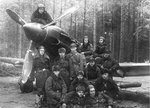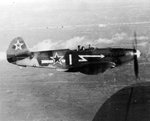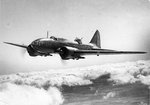- Thread starter
- #21
Alexander Arkhangelsky was already second in command at the Tupolev OKB when Andrei Tupolev was imprisoned in one of Stalin's purges. During Tupolev's absence, he was authorised to append his name to the SB variants that were in the pipeline when he took over. The Ar-2 represented a final attempt to extend the useful lifespan of the SB design which had first flown in 1934. In early 1940, Arkhangelsky had worked on a refined SB, designated Arkhangelsky MMN', but this had proved disappointing, with performance no better than the original SB. The Ar-2 was therefore a greater departure from the Tupolev design, in the hopes of creating an aircraft that could attain a speed of 600 km/h (374 mph) at 6,500 m (21,300 ft), and incorporate the newly-developed PB-3 bombsight to give dive-bombing capability. The major airframe changes made on the Ar-2 were streamlining of the engine nacelles (which now housed engines with around 15% greater power), completely new outer wing panels of greater span and taper, and a new, glazed nose. The engine cooling system was moved inside the wings, with air inlets on the leading edges and exits on the underwings. Dive brakes were added to allow for the type's new role. Initially designated SB-RK, factory testing of two prototypes commenced in October 1940, and the following month, an example was delivered to the Soviet NII-VVS for evaluation. In December, the NKAP redesignated the aircraft to incorporate Arkhangelsky's name.
The results of the NII-VVS tests were encouraging. While the hoped-for top speed was not attained, the aircraft's handling was an improvement on the SB, and the dive-bombing adaptations worked very well. Weaknesses identified included major problems with engine cooling and lubrication and deficiencies in defensive armament (the latter a common problem with Soviet bombers of the period). The report concluded that the aircraft should be put into production and development continued to eliminate the remaining defects. Production started in late 1940, but already the machine had been superseded by the Petlyakov Pe-2 and the flight of the Tupolev Tu-2 prototype. Therefore, after only 190 Ar-2s had been constructed, Zavod 22 (the aircraft factory previously devoted to Ar-2 manufacture) was turned over to Pe-2 manufacture in early 1941.
Arkhangelsky OKB continued its attempts to refine the SB, creating a final development, the SBB in 1941. All further work in this direction was terminated at the outbreak of war with Germany and Alexander Arkhangelsky was reassigned to Zavod 156 to oversee maintenance and repair of operational SB aircraft. Beginning in 1940, Ar-2s were assigned to units already operating the SB, and the two types were operated side-by-side. At least half of all Ar-2s built were destroyed during the German offensive of 1941, with a small number still operating until about 1943.
The results of the NII-VVS tests were encouraging. While the hoped-for top speed was not attained, the aircraft's handling was an improvement on the SB, and the dive-bombing adaptations worked very well. Weaknesses identified included major problems with engine cooling and lubrication and deficiencies in defensive armament (the latter a common problem with Soviet bombers of the period). The report concluded that the aircraft should be put into production and development continued to eliminate the remaining defects. Production started in late 1940, but already the machine had been superseded by the Petlyakov Pe-2 and the flight of the Tupolev Tu-2 prototype. Therefore, after only 190 Ar-2s had been constructed, Zavod 22 (the aircraft factory previously devoted to Ar-2 manufacture) was turned over to Pe-2 manufacture in early 1941.
Arkhangelsky OKB continued its attempts to refine the SB, creating a final development, the SBB in 1941. All further work in this direction was terminated at the outbreak of war with Germany and Alexander Arkhangelsky was reassigned to Zavod 156 to oversee maintenance and repair of operational SB aircraft. Beginning in 1940, Ar-2s were assigned to units already operating the SB, and the two types were operated side-by-side. At least half of all Ar-2s built were destroyed during the German offensive of 1941, with a small number still operating until about 1943.













































































